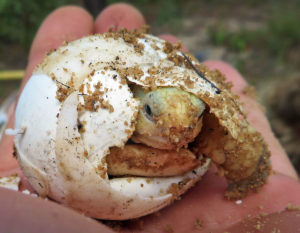S.C.’s gopher tortoise is endangered. Restoring its population could bolster other threatened species
Bo Petersen
bopete@posteandcourier.com
The Post and Courier
February 25, 2018

The ancient gopher tortoise survives because it digs burrows deep in the sand — winter refuges that save hundreds of other rare coastal creatures, too.
So the hatch of nearly 100 eggs recently at the Savannah River Ecology Lab has more value than just saving the only tortoise species in the Eastern United States. The attempt to restore an endangered, 60-million-year-old turtle species would provide a keystone to the ecology of the longleaf forests on the South Carolina coast.
Bringing it back could help any number of other endangered or threatened species to recover, such as the leopard-skinned gopher frog or the Eastern indigo snake — a dark-as-midnight species that is the largest nonvenomous native American snake
More than 300 species are estimated to use the tortoise burrows, according to the Florida Fish and Wildlife Conservation Commission.
“It all comes back to maintaining the habitat and keeping it from getting fragmented,” said Jason Ayers, U.S. Fish and Wildlife Service biologist.
The hatchlings, each the size of a pingpong ball, will be grown in the lab until spring then released when they are about the size of a dinner plate, able to fend for themselves. They would virtually double the number of current releases as part of the ongoing project that studies how many survive and if they expand their range.
Gopher tortoises can dig burrows some 10 feet deep and 30 feet long, said Will Dillman, S.C. Department of Natural Resources biologist. Because of that remarkable burrowing survival instinct, the tortoise at one time was found anywhere in the Southeast with deep sands. In South Carolina that’s much of the coastal plain east and south of the North Fork of the Edisto River near Orangeburg.
The usual culprits of predation and habitat destruction decimated the population to the point where the gopher, the only tortoise species in the Eastern United States, is considered endangered in the region. But even today, the turtle could be restored along much of its range. That’s the goal of the multi-agency project underway at the lab.
Today, the few remaining gopher tortoises in South Carolina are found in sand beds along the Savannah River. But pockets of them or individuals have been found elsewhere — either remnant populations or turtles picked up somewhere else and discarded.
In 1998, DNR biologists came across three burrows in a longleaf pine stand near Harleyville in Dorchester County. More recently, Dillman came across a single tortoise behind a gas station in Florence.
The native longleaf pine used to cover about 90 million acres of savanna sands in the Southeast, according to the Longleaf Alliance. The acreage dropped to fewer than 3 million acres, but in recent years private and public efforts have restored it to nearly 5 million acres.
The savannas are home to 30 threatened or endangered plant and animal species, 60 percent of the reptile and amphibian species in South Carolina and more than 68 bird species.
The project is a joint effort among the public agencies and the National Fish and Wildlife Foundation, funded by grants from International Paper, the alliance and American Forests.
